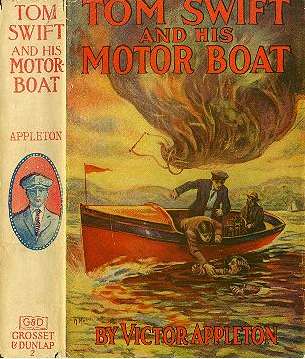
Tom Swift and His Motor-Boat
Or, The Rivals of Lake Carlopa Book #2 ©1910
By Victor Appleton
Review by JP Karenko, March 2005, Updated September 2006
White Quad Dustjacket from the collection of Mark Snyder
Note: Some of the language, references & attitudes, while acceptable at the time they were written, are not Politically Correct, today.

Summary: No official summary was ever provided with any of the old Tom Swift books. However, without giving too much away, the plot can be summed up as follows:
The book opens with Tom getting ready to attend an auction. The boat used by the criminals who stole it in Volume #1 has been damaged. The owner wants rid of it, as he has purchased a larger, more powerful craft as a replacement. Tom gets in a bidding war with one Andy Foger, a red-haired squinty-eyed bully, who likes machinery that goes fast, and edges him out by only a few dollars. A "mysterious stranger" takes an inordinate interest in the boat, and is run off after apparently trying to damage it. Later, on the trip home, Tom encounters Andy Foger, who has laid an ambush for Tom by dragging a log across the road to cause an accident. Tom is warned of the obstruction by Eradicate Sampson, an itinerant Negro handyman, and in the ensuing melee, Tom "thrashes" Andy.
Tom gets his new boat home, and begins an overhaul and modifications. The boat seems to attract trouble with repeated attempts by persons unknown to tamper with, damage and finally, to steal the craft. An electric gyroscope, developed by Tom's father Barton, is another anchor around which the rest of the story revolves. This device and some valuable tools are also stolen, causing Mr. Swift, whose health is failing due to age and overwork, much concern.
It is determined that the criminals that are causing all the mayhem are the Happy Harry Gang, a bunch of bad guys introduced in Volume #1 of the series. They seem to have several parallel agendas, which confuse things for Our Heroes. The Swifts industrial secrets are at risk, the boat-which is valued at about $900 new, and a mysterious "sparkler'" are all objects of desire and mysterious criminal intent.
Tom seems to always be in the right place at the right time to rescue people. He saves Mary Nestor (who is now considered a "friend") when her boat motor "goes back" on her out on Lake Carlopa, Mr. Damon's automobile is repaired when it malfunctions, Mr. Duncan is kept from bleeding to death after a hunting accident, and an "aeronaut," one John Sharp, is saved from a burning hot-air balloon that crashes into the lake.
The bad guys are caught and jailed, but slip away from police after a jailbreak in the "confusion of a summer storm," undoubtedly to return at a later date...
The first 25 books in this series are available on-line at the Project Gutenberg website:
Go to http://www.gutenberg.org/browse/authors/a and search on "Tom Swift."
![]()
Cast of Characters (More or less in order of appearance)
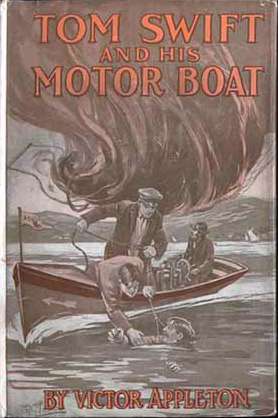
Tom Swift-Intrepid inventor & mechanic. Plucky, lively, resourceful, brave and clever. Home-schooled at a college level by his father, Barton Swift. Athlete and hunter. Familiar with how to stalk game and firearms. Loves all things mechanical.
Barton Swift-Widower. Wealthy but conservative and not flashy or pretentious. Inventor master machinist and holder of numerous patents. In this episode, described as "aged" and "working too hard."
Mrs. Baggert-Housekeeper. Kindly, and like a 2nd mother to Tom. Employed by the Swift family for 10+ years at the time of this story. Willing to feed and house strange visitors that Tom and his Dad seem to attract, without complaint.
Mr. Wakefield Damon-Elderly & eccentric adventurer whose main purpose in life seems to be blessing everybody and everything near his person. While previously trying to control his new motor-cycle, he was injured when the machine tried to "climb a tree." In this tome, he "resides in nearby Waterfield," and suffers from liver ailments. Self-described as "too stout to walk," and "cannot run." In spite of this, he is also described as "nimble for his size." Apparently quite wealthy, he has graduated from cycles to automobiles. He has serious engine trouble, which Tom repairs, handily.
Andy Foger-Red haired, squinty-eyed bully, who makes great trouble for Tom. "Poor little rich kid," son of wealthy family, born with a chip on his shoulder. Reckless, blustery and angry. Showoff. "Has money, and not much else." Lately has acquired a racing motor-boat.
Sam Snedecker-Cohort of Andy Foger. Voice of reason to Andy's scream of rage. No description given.
Ned Newton-Chum & companion of Tom, currently employed in a Shopton bank. In this episode, we find out Ned is an avid photographer and also loves boating & camping.
Tod Boreck, A.K.A. "Murdock"-The Well-Dressed stranger in a white straw hat. Thief. Dishonorable, even toward his criminal buddies.
Mr. Jacob Wood-Auctioneer who sells Tom the motor-boat.
Mr. Hastings-NFN or description given. Previous owner of the BIQ (Boat-In-Question.) Has upgraded to a larger, faster ,4-cylinder model. He is disposing of the Carlopa/Arrow, as it was damaged when stolen.
The "Happy Harry" Gang-Now named as such. These guys show up singly and in groups throughout the story.
Jake Burke, A.K.A. "Happy Harry"-Ringleader & brains of the outfit. Educated, and plays the part of a tramp, poorly. Tattoo of a ring on the small finger of his left hand. Constantly trying to steal Barton Swift's patent models and plans.
Anson Morse-Snappy dresser who on occasion wears kid (leather) gloves. Black moustache. Uses a false beard while playing the part of a bum. Sneak-thief who steals papers from Swift property. Apparently also well-educated.
Wilson Featherton, A.K.A. "Simpson"- Thug / muscle for the gang. Knows knockout techniques and drugs. Acts as chauffeur/driver for gang.
Ferguson Appleson-Thug / muscle for gang.
Eradicate Andrew Jackson Abraham Lincoln Sampson, A.K.A. Rad-Aged stereotypical Negro journeyman jack-of-all-trades. Chicken-coop cleaner and whitewasher. "Eradicates dirt." Also makes a living mowing grass, and sawing wood. Gives the appearance of being lazy, but is actually a hard worker and entrepreneur/wheeler-dealer. Heavy deep-south accent and Uncle Remus attitude. Caretaker of mule Boomerang.
Garrett Jackson-Aged "engineer" who runs and maintains the steam plant and engine(s) used to power the Swift's belt-driven machine tools. Lives in a shack on the Swift property. Acts as a watchman and handyman around the Swift estate.
Miss Mary Nestor & Friends-Rescued by Tom when her boat, the Dot, malfunctions. Described as a "fair young woman with flashing brown eyes." Blushes easily, especially around Tom. Resides in Mansburg, with her father & mother. Greets Tom at a church picnic, and he meets her parents. Later is called Tom's "friend."
Jennie Haddon-Has an eye for Tom. Enjoys having Tom "explain things mechanical" to her. No description.
Miss Carson-NFN given. Passing mention. No description.
Theodore Duncan-Hunter who in this episode shoots himself accidentally and is saved from bleeding to death by Tom.
Dick Blythe-No description. Owns the boat Dot and a cottage on Lake Carlopa. "Sort of a 2nd cousin" to Mary Nestor.
Pete Bailey-Cohort of Andy Foger Passing mention.
Mrs. Foger-NFN given. Kindly, genteel, polite and gracious. Everything her son, Andy is not. Clueless as to Andy's true demeanor. Thinks he is just "troubled."
John Sharp-Professional balloonist and trapeze artist. Wears tights with spangles, and speaks in short terse sentences. Rescued by Tom when his hot-air balloon gets a bit too hot and burns. Deputy Sheriff as a sideline. Co-designer with Tom, of an Aeroplane Dirigible Airship, to be introduced in book #3.
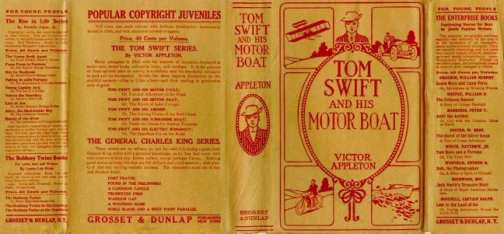
(Very rare brown quad dustjacket, courtesy of James Keeline; found on very early editions)
![]()
Major Inventions
Once again, Tom Swift didn't really "invent" anything in this book.. He did do significant engineering development work on a damaged boat that was purchased at auction. His modifications included changing the ignition system & plugs, the water pump, adding a pressure oiling system and installing a weather canopy with side curtains. These changes, along with a stronger fuel tank mounting, improved the performance of the machine, increasing the top speed enough to keep up with a 3-cylinder racing boat of the "automobile launch" variety. Auto launches had the motor forward, under a Model A style "batwing" hood arrangement.. Tom's boat was a 21ft-12-seater "family cruiser" with a 10hp, 2-cylinder, 2-cycle motor able to go 10mph at top speed, before Tom's modifications. The motor was amidships, and presumably exposed as Tom was constantly tinkering with it to maximize the performance.
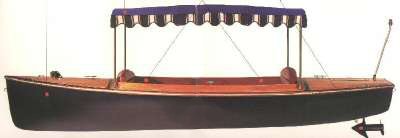
1910 era "Family Cruiser"
These boats had manual adjustment "gasolene" and sparking levers. Performance was maximized "by ear," as no instruments of any kind were mentioned in the story. Ignition was provided by either magneto or dry cell (presumably used with an automobile-type "spark coil.") Ignition and fuel systems were quite unreliable, and required constant tinkering.
The main invention in this story was once again made by Tom's dad. It was an electric powered gyroscope to be used for "making aeroplanes more stable in wind."
Barton, always the opportunist around machinery , also had ideas for a new "kitchen boiler," which is surmised to be either a water heater or maybe a dishwashing machine.
Late in the story, Tom and John Sharp collaborate on the design of a dirigible/aeroplane airship, to be chronicled in the next volume of the series.
![]()
Commentary On Society, Attitudes, Environment & Errata
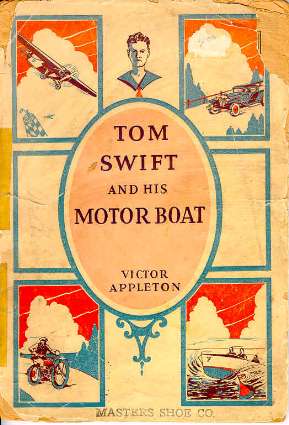
It's amazing how much society and technology have changed. At this reading in 2005, this book is 95 years old. The list price of this volume was $0.40 postpaid from the publisher.
Attitudes and Prejudices-Society and attitudes are/were very different at the beginning of the 1900's. African-Americans were heavily stereotyped and were invariably portrayed as poorly educated and speaking a deep-south slave-patois. At least in this volume, denigrating terms were not noted when reference was made to other than white skinned people. Other tales in the series will not be so considerate to persons of color.
Women were relegated to the status of ornaments. It was considered "curious" for a female to drive an automobile, or to go unescorted, especially after dark. "Girls don't know much about machinery." As a whole, Mary Nestor is un-stereotypical, being willing to take the risk of operating a small motor-boat without male assistance. She does, however require rescue and blushes prettily when around Our Hero. Machinery was unreliable, and when it went wrong, it was described as "going back." Automobiles had to be "cranked up" by hand, either from the front or side. Shoes had buttons.
Language usage was quaint. The author has discovered the word "clew" (British spelling) and uses it a lot. However, while the previous volume used the British spelling of gasolene for petroleum fuel, in this tale the familiar American spelling is utilized. Several authors had a hand in writing these stories, and they were never definitively identified. I feel that language usage and societal attitudes will play a major part in at least grouping the stories by any given ghost writer together. I speculate further, below.
"Hoodoo" was an unseen miasma like "bad luck" (but not as bad as a curse.) When present, it made things go wrong. Most bad-guys seemed to speak a form of "thug-ese," which involved poor grammar and the use of "youse" when referring to others. "Trimming" meant cheating your criminal friends. (We'd use "skim" today.) Bad-guys invariably wore facial hair, usually of the bushy-beard variety. Throughout this series, bushy beard=bad guy.
Lots of old-school common sense was dispensed with one-liners, such as "Speculation is idleness," "Worry is bad for digestion" and "One thing at a time."
Police were ineffective, and were mainly useful for "looking wise." They would promise to "do all they can," which was described as "not much." Captured crooks escaped jail due to "confusion during a storm." Vigilante-type justice was the order of the day, with citizens taking capturing criminals and settling scores into their own hands without fear of litigation. It was apparently common to go armed. Tom kept a shotgun in his boat and another at his home, but "only to intimidate, not to shoot" bad guys. When dealing with Andy, Tom was described as being "able to do as well as the police" when evening the score. This was done with bare knuckles-"thrashing" was adequate redress back then, for wrongs that would end up in court, today.
Taking in a stranger as a houseguest for a night or even several weeks, was apparently not unusual or a cause for concern in those days. Rendering aid to those in distress was commonplace and expected. An injured aeronaut is treated by the Swifts' personal physician, apparently without cost. Doctors made house calls in those days. Interestingly, the author(s) in this series treated all medical men with disdain, almost never giving them even the courtesy of a physical description or first names. Even when named, only rarely in the series is the same doctor called upon to perform a service more than once. Tom's first-aid skill making a tourniquet saved Mr. Duncan from bleeding to death, but burn treatment has changed, dramatically. Putting oil or Vaseline on burns, as they did in the story, would make a modern doctor recoil in horror. Good Samaritans ruled in Tom Swift's world.
Speculation As To Author's Identity- The running gag about Mr. Damon's home town (it keeps flip-flopping between Waterford and Waterfield during the series) has not yet begun. It has been concluded elsewhere that the 1st five volumes of this series were all written in toto by Edward Stratemeyer, their creator. James Keeline states that specific documentation exists tying the first two volumes of this series firmly to Howard Garis, a ghost writer who is said by some to have penned most of these tales. Many later volumes were sub-contracted to a whole series of ghost writers, who were contractually unable to communicate with one another. Writing styles varied enough that no one author (such as Garis) could have penned them all. It is interesting to note that if Mr. Stratemeyer did write all of the 1st five, even he couldn't keep the details straight. In Volume 1, 2 & 5, Mr. D's home is Waterfield. In Volume 3, Waterford is "it" and in Volume 4, no home town is specified. Frankly, the writing style in #4 is enough different, that I'd hesitate to put any money on a bet that Ed Stratemeyer did anything but outline these stories or possibly only review the finished product.
In spite of these inconsistencies, this particular tome has the right "feel" to have come from the pen of The Master. Perhaps The Master really was Garis, not Stratemeyer.
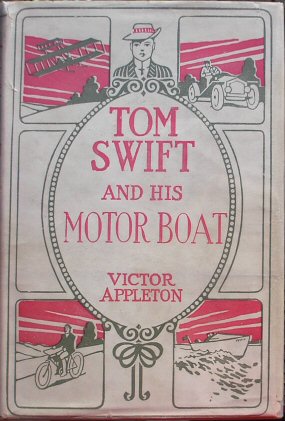
Errata-that were noticed were limited. The Lanton Motor Boat Club on p.176 was first referred to as the Lanton Motor Club on p59. There was some confusion about "up" and "down," when referring to directions. At least in this hemisphere, most folks refer to anything more northerly than where they are as, "up" there. By the same convention, anything more southerly than where the speaker was is "down" there. Sandport, at the south end of the lake, was several times referred to as "up here" when compared to the rest of Lake Carlopa and Shopton. No mention was made of an altitude change, such as the resort being on a hillside. That part of New York State is quite hilly, being surrounded by the Adirondack Mountains on the west and Vermont's Green Mountains on the east.
Geography-of upstate New York remains authentic and is further described. Woods that overhang the lakeshore are common, and make NY lakes picturesque. The fictional Lake Carlopa. is further described as "cut up with bays and gulfs," and having the resort town of Sandport at its' south end. It is 5 miles across, implying the long axis runs north/south. The lake is estimated to be about 80-100 miles in length. This is based on the logic that Shopton is about halfway up the east (right-hand from Sandport) shore of the lake. It takes 8 hours to reach by a boat able to do a maximum of 10mph, but not running wide open. It is also stated that it takes at least "several" days to circumnavigate the lake. The most likely real bodies of water in New York State that Carlopa could have been modeled from are Lake Champlain which is the right size (but has its east shore in Vermont, and north end in Canada) or Lake George, which is actually a bit small (35mi long by 2.5mi wide.) Lake George, does have the numerous bays and gulfs, the many small islands (pivotal in later stories) and small towns at both ends. (George is my main choice.) The finger lakes are also pretty small, and not as "upstate" as L. George. L. Oneida, the only other sizeable lake in the vicinity, has the wrong proportions and topography.
Mansburg, a sizeable town and current home to Mary Nestor, is south of Shopton. Waterfield, home of Mr. Damon, (at least in this episode) is south of Mansburg, and is close enough for a casual ride via horse, bike or auto.
The town of Lanton is described as being at the north (head) end of the lake. Daleton is about 20 miles north of Sandport on the west shore and is roughly halfway between Sandport and Shopton. A town named Pratonia is described as "15 miles" inland (further west) from Daleton. There is also an unnamed sanatorium on the west shore, north of Daleton where surgical and other ill patients recover their strength. The nearest real sanatorium is located in Glens Falls, about 25mi south of "Sandport," and decidedly not on the lakeshore.
There are no recognizable "real" NY landmarks named in this story, so all of the above is my speculation.
Tom's home is further described as being a "mansion" with a boathouse and an orchard, on an "unpaved country lane." The property is described as an estate, and sports a steam generating plant and engine(s) to power belt-driven machine tools. At least one major "shop" specializing in electrical machinery is also present. Swift Construction Company, per se, does not yet exist as an entity.
![]()
Tom Swift and his Motor-Cycle | Tom Swift and His Airship | Index